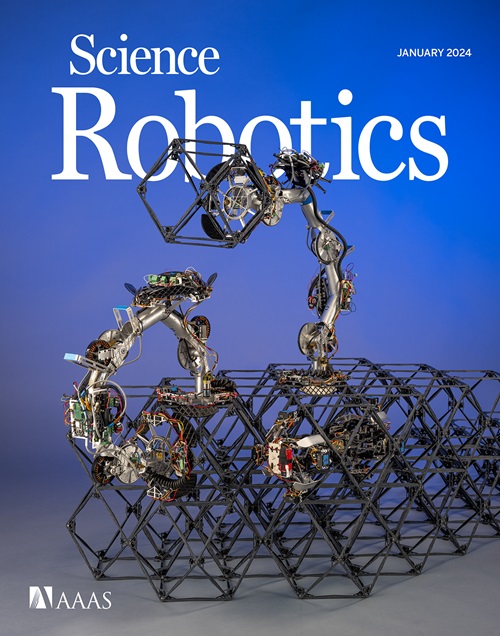用于三维空间时空感知的立体人工复眼。
IF 27.5
1区 计算机科学
Q1 ROBOTICS
引用次数: 0
摘要
节肢动物的眼睛因其结构的独特性而成为有效的生物视觉系统,可用于物体追踪和宽视场;然而,与哺乳动物的眼睛不同,节肢动物的眼睛因其单眼线索而很难获取静态物体的深度信息。因此,大多数节肢动物依靠运动视差来跟踪三维空间中的物体。独特的是,螳螂(Mantodea)同时使用复眼结构和一种立体视觉,能够在三维空间中识别物体。在这里,我们通过使用立体耦合人工复眼模仿螳螂的视觉系统,演示了在三维空间中以宽视场进行时空物体感应和跟踪。此外,为了以最小的延迟、数据存储/传输和功耗实现快速响应,我们在系统边缘使用突触装置和联合分裂学习算法处理视觉信息。设计和制造的立体人工复眼可提供高能效、高精度的时空物体感应和光流跟踪。它的均方根误差为 0.3 厘米,传感和跟踪仅消耗约 4 毫焦。这些结果比基于互补金属氧化物半导体的传统成像系统低 400 多倍。我们的仿生成像仪展示了利用软硬件编码设计技术整合大自然独特设计的潜力,从而实现边缘计算和传感功能。本文章由计算机程序翻译,如有差异,请以英文原文为准。
Stereoscopic artificial compound eyes for spatiotemporal perception in three-dimensional space
Arthropods’ eyes are effective biological vision systems for object tracking and wide field of view because of their structural uniqueness; however, unlike mammalian eyes, they can hardly acquire the depth information of a static object because of their monocular cues. Therefore, most arthropods rely on motion parallax to track the object in three-dimensional (3D) space. Uniquely, the praying mantis (Mantodea) uses both compound structured eyes and a form of stereopsis and is capable of achieving object recognition in 3D space. Here, by mimicking the vision system of the praying mantis using stereoscopically coupled artificial compound eyes, we demonstrated spatiotemporal object sensing and tracking in 3D space with a wide field of view. Furthermore, to achieve a fast response with minimal latency, data storage/transportation, and power consumption, we processed the visual information at the edge of the system using a synaptic device and a federated split learning algorithm. The designed and fabricated stereoscopic artificial compound eye provides energy-efficient and accurate spatiotemporal object sensing and optical flow tracking. It exhibits a root mean square error of 0.3 centimeter, consuming only approximately 4 millijoules for sensing and tracking. These results are more than 400 times lower than conventional complementary metal-oxide semiconductor–based imaging systems. Our biomimetic imager shows the potential of integrating nature’s unique design using hardware and software codesigned technology toward capabilities of edge computing and sensing.
求助全文
通过发布文献求助,成功后即可免费获取论文全文。
去求助
来源期刊

Science Robotics
Mathematics-Control and Optimization
CiteScore
30.60
自引率
2.80%
发文量
83
期刊介绍:
Science Robotics publishes original, peer-reviewed, science- or engineering-based research articles that advance the field of robotics. The journal also features editor-commissioned Reviews. An international team of academic editors holds Science Robotics articles to the same high-quality standard that is the hallmark of the Science family of journals.
Sub-topics include: actuators, advanced materials, artificial Intelligence, autonomous vehicles, bio-inspired design, exoskeletons, fabrication, field robotics, human-robot interaction, humanoids, industrial robotics, kinematics, machine learning, material science, medical technology, motion planning and control, micro- and nano-robotics, multi-robot control, sensors, service robotics, social and ethical issues, soft robotics, and space, planetary and undersea exploration.
 求助内容:
求助内容: 应助结果提醒方式:
应助结果提醒方式:


